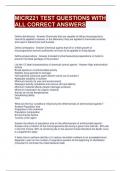Exam (elaborations)
MICR221 TEST QUESTIONS WITH ALL CORRECT ANSWERS
- Course
- Institution
MICR221 TEST QUESTIONS WITH ALL CORRECT ANSWERS Define disinfectant - Answer-Chemicals that are capable of killing microorganisms, cannot be applied to tissues, in the laboratory they are applied to inanimate surfaces and used in discard jars and buckets Define antiseptics - Answer-Chemical ag...
[Show more]



